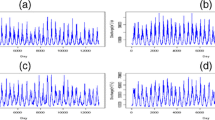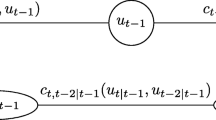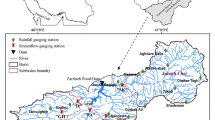Abstract
In this study, Vector Autoregressive-Generalized Autoregressive Conditional Heteroskedasticity (VAR-GARCH), copula, and copula-GARCH models were used for joint frequency analysis of storms in the Aras river basin in northwestern Iran in period of 1998–2018. The heteroskedasticity in the series was considered using the vector autoregressive model. Two-dimensional copulas were also used for bivariate analysis. After confirming the correlation between the pair variables of storm with one event lag (S1) and storm with no lag (S0), bivariate frequency analysis was performed. In the simulation step, the residual series of the VAR model was extracted and fitted to the GARCH model. Then, the residual series of the GARCH model was modeled using the copula model. Finally, storm with no lag (S0) affected by storm with one event lag (S1) was simulated by VAR-GARCH, copula, and copula-GARCH models. According to the coefficient of determination (R2) and Nash–Sutcliffe Efficiency coefficient (NSE) and root mean square error (RMSE), the VAR-GARCH model had higher accuracy than copula and copula-GARCH models. The RMSE in the simulation of storm height using the VAR-GARCH model was estimated to be 18% and 11% less than copula and copula-GARCH models, respectively. The VAR-GARCH model provided higher accuracy in the simulations due to the consideration of different lags in the simulations and modeling the variance of the residual series. According to the Taylor diagram, the certainty of all three models in simulating storm height are acceptable. Finally, by two-dimensional analysis of pair variables of storm height and storm duration, typical curve was produced that can estimate the storm duration with different probabilities. In fact, having the storm information that has happened in the present can accurately predict the next storm information. It can be very useful in flood management and the generated curves can be used as a flood warning system in the basin.

















Similar content being viewed by others
Data availability
The datasets generated during and/or analyzed during the current study are available from the corresponding author on reasonable request.
Code availability
It is available from the first author upon reasonable request.
References
Aas K, Czado C, Frigessi A, Bakken H (2009) Pair-copula constructions of multiple dependence. Insurance Math Econom 44(2):82–198
Akbarpour A, Zeynali MJ, Tahroudi MN (2020) Locating optimal position of pumping Wells in aquifer using meta-heuristic algorithms and finite element method. Water Resour Manage 34(1):21–34
Ayantobo OO, Li Y, Song S, Javed T, Yao N (2018) Probabilistic modelling of drought events in China via 2-dimensional joint copula. Journal of Hydrology 559:373–391
Bezak N, Rusjan S, Kramar Fijavž M, Mikoš M, Šraj M (2017) Estimation of suspended sediment loads using copula functions. Water 9(8):628
Bollerslev T (1992) Chou RY Kroner KF ARCH Modeling in Finance A Selective Review of the Theory and Empirical Evidence. Journal of Econometrics 52:5–59
De Michele C, Salvadori G, Passoni G, Vezzoli R (2007) A multivariate model of sea storms using copulas. Coast Eng 54(10):734–751
Dißmann JF (2010) Statistical inference for regular vines and application Master’s thesis. Tech-nische Universität München
Duan JC (1996) A unified theory of option pricing under stochastic volatility-from GARCH to diffusion Hong Kong University of Science and Technology
Engle RF (1982) Autoregressive conditional heteroscedasticity with estimates of the variance of United Kingdom inflation Econometrica: Journal of the Econometric Society:987–1007.
Floros C, Jaffry S, Lima GV (2007) Long memory in the Portuguese stock market Studies in Economics and Finance
Guo A, Wang Y (2017) Assessment of variability in the hydrological cycle of the Loess Plateau, China: examining dependence structures of hydrological processes AGUFM, 2017, GC41C-1028.
Joe H (1997) Multivariate models and multivariate dependence concepts London: Chapman Hall, 399.
Kendall MG (1938) A New Measure of Rank Correlation. Biometrika 36:81–93
Khozeymehnezhad H, Nazeri-Tahroudi M (2020) Analyzing the frequency of non-stationary hydrological series based on a modified reservoir index. Arab J Geosci 13(5):1–13
Khozeymehnezhad H, Tahroudi MN (2019) Annual and seasonal distribution pattern of rainfall in Iran and neighboring regions. Arab J Geosci 12(8):271
Kim JE, Yoo J, Chung GH, Kim TW (2019) Hydrologic risk assessment of future extreme drought in South Korea using bivariate frequency analysis. Water 11(10):2052
Krämer W, Ploberger W, Schlüter I (1991) Recursive vs OLS residuals in the CUSUM test In Economic Structural Change (35–47) Springer, Berlin, Heidelberg
Li F, Zheng Q (2016) Probabilistic modelling of flood events using the entropy copula. Adv Water Resour 97:233–240
Ma M, Song S, Ren L, Jiang S, Song J (2013) Multivariate drought characteristics using trivariate Gaussian and Student t copulas. Hydrol Process 27(8):1175–1190
Mann HB (1945) Nonparametric Test against Trend. Econometrica 13:245–259
Mendenhall W, Reinmuth J (1982) Statistics for management and economics, 4th edn. Duxbury Press
Modarres R, Ouarda T (2012) Generalized autoregressive conditional heteroscedasticity modelling of hydrologic time series. Hydrol Process 27(22):3174–3191
Moffat IU, Akpan EA, Abasiekwere UA (2017) A Time Series Evaluation of the Asymmetric Nature of Heteroscedasticity: an EGARCH Approach. Int J Stat Appl Math 2(6):111–117
Nash JE, Sutcliffe JV (1970) River flow forecasting through conceptual models part I—a discussion of principles. Journal of hydrology 10(3):282–290
Nazeri TM, Khalili K (2015) Comparing combined ARMA-PARCH and ARMA-ARCH models for modeling peak flow discharge (case study: Siminehrood River in the West Azarbaijan Province). Water Soil Sci (Agricultural Science) 25(4/1):113–127
Nazeri TM, Khalili K (2018) Comparison between ARMA and ARMA-PARCH models in modeling the annual river discharge (Case study: Zarineh-Rood river in the West Azerbaijan province). Iranian Water Res J 12(30):71–80
Nazeri TM, Khalili K, Abbaszadeh AM, Behmanesh J (2017) Evaluation of Combined ARMA-ARCH and BL-ARCH Models in Modeling Lake Urmia Water Level. Irrigation Sci Eng (JISE) 40(1):177–189
Nazeri Tahroudi M, Ramezani Y, De Michele C, Mirabbasi R (2022) Application of copula functions for bivariate analysis of rainfall and river flow deficiencies in the Siminehrood River Basin. Iran J Hydrol Eng 27(11):05022015
Nelsen R (2006) An introduction to copulas New York. Springer
Nelson DB (1991) Conditional heteroskedasticity in asset returns: a new approach Econometrica: J Econ Soc. 347–370.
Raji M, Tahroudi MN, Ye F, Dutta J (2022) Prediction of heterogeneous Fenton process in treatment of melanoidin-containing wastewater using data-based models. J Environ Manage 307:114518
Ramezani Y, Tahroudi MN (2020) Improving the performance of the SPEI using four-parameter distribution function. Theoret Appl Climatol 139(3):1151–1162
Ramezani Y, Tahroudi MN, Ahmadi F (2019) Analyzing the Droughts in Iran and Its Eastern Neighboring Countries Using Copula Functions. Idojaras 123(4):435–453
Ramezani Y, Khashei-Siuki A, Tahroudi MN (2020) Spatial distribution of the daily, monthly, and annual precipitation concentration indices in the Lake Urmia basin. Iran Idojaras, Quarterly J Hungarian Meteorol Service 124(1):73–95
Salvadori G, De Michele C, Kottegoda NT, Rosso R (2007) Extremes in nature: an approach using copulas (56) Springer Science Business Media.
Scott Hacker R, Hatemi-J A (2008) Optimal lag-length choice in stable and unstable VAR models under situations of homoscedasticity and ARCH. J Appl Stat 35(6):601–615
Serinaldi F, Bonaccorso B, Cancelliere A, Grimaldi S (2009) Probabilistic characterization of drought properties through copulas Physics and Chemistry of the Earth. Parts a/b/c 34(10–12):596–605
Shahidi A, Ramezani Y, Nazeri-Tahroudi N, Mohammadi S (2020) Application of vector autoregressive models to estimate pan evaporation values at the Salt Lake Basin. Iran Idojaras 124(4):463–482. https://doi.org/10.28974/idojaras.2020.4.3
Sims CA (1980) Macroeconomics and reality Econometrica: J Econ Soc. 1–48.
Sklar A (1959) Fonctions De Répartition à n Dimensions Et Leurs Marges Publications De L’institut De Statistique De L’université De Paris 8:229–231
Sungur EA, Yang Y (1996) Diagonal Copulas of Archimedean Class Communications in Statistics-Theory and Methods 25(7):1659–1676
Tahroudi MN, Khalili K, Ahmadi F, Mirabbasi R, Jhajharia D (2019a) Development and application of a new index for analyzing temperature concentration for Iran’s climate. Int J Environ Sci Technol 16(6):2693–2706
Tahroudi MN, Pourreza-Bilondi M, Ramezani Y (2019b) Toward coupling hydrological and meteorological drought characteristics in Lake Urmia Basin. Iran Theor Appl Climatol 138(3–4):1511–1523
Tahroudi MN, Ramezani Y, Ahmadi F (2019c) Investigating the trend and time of precipitation and river flow rate changes in Lake Urmia basin. Iran Arabian J Geosci 12(6):219
Tahroudi MN, Ramezani Y, De Michele C, Mirabbasi R (2020a) A new method for joint frequency analysis of modified precipitation anomaly percentage and streamflow drought index based on the conditional density of copula functions. Water Resour Manage 34:4217–4231. https://doi.org/10.1007/s11269-020-02666-6
Tahroudi MN, Ramezani Y, De Michele C, Mirabbasi R (2020b) Analyzing the conditional behavior of rainfall deficiency and groundwater level deficiency signatures by using copula functions. Hydrol Res 51(6):1332–1348. https://doi.org/10.2166/nh.2020.036
Tesfaye YG, Meerschaert MM, Anderson PL (2006) Identification of periodic autoregressive moving average models and their application to the modeling of river flows. Water Resour Res 42(1):1–11
Tse YK, Tsui AKC (2002) A multivariate generalized autoregressive conditional heteroscedasticity model with time-varying correlations Journal of Business Economic. Statistics 20(3):351–362
Wang W, Van Gelder PH, Vrijling JK, Ma J (2005) Testing and Modelling Autoregressive Conditional Heteroskedasticity of Streamflow Processes. Nonlin Processes Geophys 12:55–66
Watanabe T (2012) Quantile forecasts of financial returns using realized GARCH models. The Japanese Economic Review 63(1):68–80
Wilcoxon F (1945) Individual Comparison by Ranking Methods. Biometrics 1(6):80–83
Yoo J, Kim D, Kim H, Kim TW (2016) Application of copula functions to construct confidence intervals of bivariate drought frequency curve. J Hydro-Environ Res 11:113–122
Yuan X, Tang J, Wong WK, Sriboonchitta S (2020) Modeling co-movement among different agricultural commodity markets: a copula-GARCH approach Sustainability 12(1):393
Yusof F, Kane IL (2013) Volatility modeling of rainfall time series. Theoret Appl Climatol 113(1–2):247–258
Zhang L, Singh V (2006) Bivariate flood frequency analysis using the copula method. J Hydrol Eng 11(2):150–164
Acknowledgements
The authors would like to thank Iran’s Meteorological Organization (IRIMO) for providing the data.
Funding
The authors would like to acknowledge the financial support of University of Birjand for this research under contract number 1399/D/15691.
Author information
Authors and Affiliations
Contributions
All authors contributed to the study conception and design. Data collection, analysis, and general literature review were performed by M. Nazeri Tahroudi. The first draft of the manuscript was written by M. Nazeri Tahroudi. Y. Ramezani has supervised the research work. Y. Ramezani, C. De Michele, and R. Mirabbasi have reviewed and commented on the first draft of the manuscript. All authors read and approved the final version of the manuscript.
Corresponding author
Ethics declarations
Ethics approval
Not applicable.
Consent to participate
Not applicable.
Consent for publication
Not applicable.
Conflict of interest
The authors declare no competing interests.
Additional information
Publisher's note
Springer Nature remains neutral with regard to jurisdictional claims in published maps and institutional affiliations.
Highlights
1. With a simulation approach based on hybrid models and copula functions, the values obtained from the bivariate frequency curve will be more reliable. Due to the heteroskedasticity in various meteorological and hydrological data, the use of nonlinear ARCH models may increase the accuracy of the simulations.
2. The aim of the present study was to investigate the performance of the VAR-GARCH model, copula model, and copula-GARCH model in simulating pair variables of storm with no lag (S0) affected by storm with one event lag (S1) in the Aras river basin, Iran.
3. By two-dimensional analysis of pair variables of storm height and storm duration, typical curve was produced that can estimate the storm duration with different probabilities.
4. Having the storm information that has happened in the present can accurately predict the next storm information.
5. It can be very useful in flood management and the generated curves can be used as a flood warning system in the basin.
Rights and permissions
Springer Nature or its licensor (e.g. a society or other partner) holds exclusive rights to this article under a publishing agreement with the author(s) or other rightsholder(s); author self-archiving of the accepted manuscript version of this article is solely governed by the terms of such publishing agreement and applicable law.
About this article
Cite this article
Ramezani, Y., Nazeri Tahroudi, M., De Michele, C. et al. Application of copula-based and ARCH-based models in storm prediction. Theor Appl Climatol 151, 1239–1255 (2023). https://doi.org/10.1007/s00704-022-04333-9
Received:
Accepted:
Published:
Issue Date:
DOI: https://doi.org/10.1007/s00704-022-04333-9




